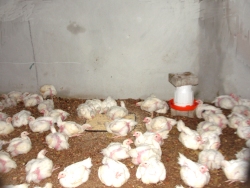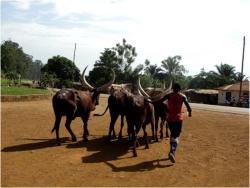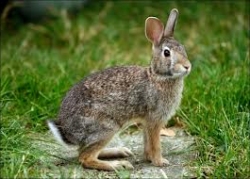
|
Contact usUnited CaribbeanFood For Life
Barbados Super Foods
Guyana Agro/Eco TourismOrganic Super Fruits IndexSt Lucia Super FruitsDominica Super ChocolateSuriname Super SeedsGrenada Super SpiceUCT ProjectsUCT Agricultural CurriculumCaribbean Relief
Alternative Animal Fodder |
home >> the
miracle tree>>food for life
haiti>>animal fodder Animal fodder foods Chickens
Hence, there is a need to search for locally available alternative sources of protein for use as feed supplement to poultry. Feed costs amount to a considerable proportion of production cost in any intensive livestock production system . It has been reported that, feed cost represents up to 60-80% of the total cost of broiler production. Fishmeal, a conventional feed resource, has been used as the source of animal protein in diets of poultry in many countries due to unavailability of cheaper alternative protein sources. With the present trend of rising prices of feedstuffs, considerable attention has been placed on the search for non-conventional feedstuffs. Various leaf meals have been used in poultry diets, including not only Mringa but those of Leucaena and Mulberry. In laying hens, the recommended inclusion rate for leucaena leaf meal is 10 % Mulberry is another excellent feedstuff plant due to its good adaptability, long cultivation history, mature planting techniques, high leaf yield, abundant nutrition, and a great deal of active substances of health care. Mulberry leaf powder supplementation at 10% would cut down the cost of poultry feed. In addition the protein from Benzoliv leaves may be fed to poultry in the form of leaf protein concentrate. Benzoliv leaf meals do not only serve as protein source but also provide some necessary vitamins, minerals and oxycaretenoids which cause yellow colour of broiler skin, shank and egg yolk. Feeding chickens with Benzoliv leaves and seeds will improve egg production. The inclusion of Benzoliv oleifera leaves meal up to 30% in the diet of growing traditional Senegal chickens had no negative impact on live body weight,average daily weight gain, feed conversion ratio, carcass and organs characteristics, health and mortality rate in birds compared to their controls. Considering these results and the high price of raw ordinary ingredients, particularly protein ingredient sources in poultry feeding; the recovering of these leguminous leaves in the diets of chickens is a real opportunity for traditional stockholders to improve at lower cost, not only the productivity and nutritional status of their birds but also their income with a 50% saving. |
|
Other animalls Benzoliv leaves are readily eaten by cattle, sheep, goats, pigs and rabbits. Branches are occasionally lopped for feeding cattle. The residents cut back the main stem to encourage side shoots which they use for livestock feeding. Leaves can also be used for fish. Sourced www.jsdafrica.com Cattle
The high protein content of Benzoliv leaves must be balanced with other energy food. Cattle feed consisting of 50% Benzoliv leaves should be mixed with molasses, sugar cane, sweet (young) sorghum plants, or whatever else is locally available. Care must be taken to avoid excessive protein intake. Too much protein in pig feed will increase muscle development at the expense of fat production. In cattle feed, too much protein can be fatal (from alteration of the nitrogen cycle). Cattle were fed 15-17 kg of Benzoliv daily. Milking should be done at least three hours after feeding to avoid the grassy taste of Benzoliv in the milk. With Benzoliv feed, milk production was 10 liters/day. With Benzoliv feed, daily weight gain of beef cattle
was 1,200 grams/day. The higher birth weight (3-5 kg) can be problematic for small cattle. It may be advisable to induce birth 10 days prematurely to avoid problems. Incidence of twin births also increased dramatically with Benzoliv feed: 3 per 20 births as opposed to the usual average of 1:1000. Information sourced from www.nairaland.com In addition Mulberry trees that can be grown under varied climatic condition, including fallow and wastelands not fit for agriculture can be used, totally or partly, for producing nutritious green fodder. Feeding mulberry as part of the daily ration of cows, improved the quality and quantity of milk and reduced calving intervals. Pigs
Rabbits
Sourced: dspace.knust.edu.gh: Mulberry fodder in rabbit production: The high levels of nurtriants intake and digestibility confirm the high nutritive value of mulberry eaves and their potential as a forage that can support rabbit production. With comparable DM intake, digestibility and weight gain as in all-concentrate ration achieved with up to 50% substitution of concentrate in rations, rapid growth rate of rabbits can be achieved at less cost. Where marketing opportunities does not necessitate rapid weight gains, producers may chose to substitute more concentrate or even feed mulberry leaves as a sole diet to achieve satisfactory gains at even lower costs. A DROP OF HOPE
GROW AND GO CURRICULUM
|
| Copyright © 2024 www.UnitedCaribbean.com. All rights reserved. Disclaimer Click to Contact us |






















































